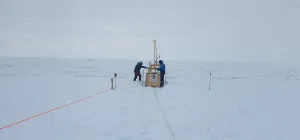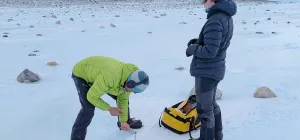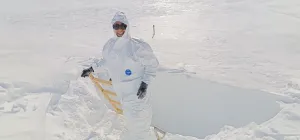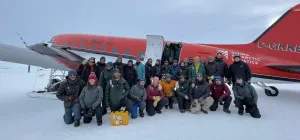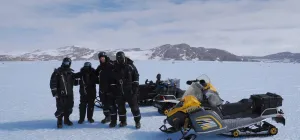Arctic Arc Results Presented to the European Space Agency

On May 19th, polar explorer Alain Hubert, founder of the International Polar Foundation, visited the European Space Agency (ESA) to hand over a unique set of snow-depth measurements which had been collected during his 2007 Arctic crossing. This dataset makes a valuable contribution to the validation programme of ESA's ice mission CryoSat.
As a reminder, ESA was a technical partner of the "Arctic Arc" expedition which saw Alain and fellow explorer Dixie Dansercoer cross the Arctic, from Russia to Greenland on foot via the North Pole. The two explorers crossed 1654 km in 106 days and, despite the terrible weather and ice conditions, they collected snow thickness measurements for ESA at regular intervals every 50 km throughout their expedition.
The Earth Explorer CryoSat mission is due for launch next year. It is designed to measure tiny variations in the thickness of floating sea-ice and ice on land. Understand the effects that the overlying snow can have on the measurement of ice elevation is therefore of huge importance. Measurements collected on the ice and from the air are crucial to fully understand and characterise the geophysical uncertainties in the CryoSat products.
"It wasn't really difficult to take these measurements for CryoSat," said Alain, "It became part of our routine. The difficult part of the expedition was putting one foot in front of the other when the ice is breaking up around you. As co-founder of the International Polar Foundation, and as a scientist as well as a seasoned explorer - I aim to form a kind of 'bridge' between science and society. Observing the changes that are occurring in the fragile Arctic environment will help lead to a better understanding of the effects of climate change and ultimately the Earth system as a whole. CryoSat is an exciting mission that will help answer questions about the polar ice, so we were very happy to contribute through our Arctic Arc expedition."
Malcolm Davidson ESA's CryoSat Validation Manager noted that "ESA has now released the snow-depth data collected by the Expedition to the CryoSat Validation and Retrieval Team. The team has been quite eager to get the data and start the analysis. Ultimately we expect that - in conjunction with the core ESA-sponsored airborne campaigns and similar initiatives from other polar expeditions - the data will help us better measure ice thickness changes from space with CryoSat-2".
Below, you will find some web links which provide you with more context on the expedition.
Download











